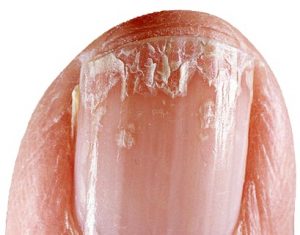 Have you ever stopped to look at your fingernails and toenails? No, not at the manicure session or to make sure they’re clean, but at the nail itself? Your nails are the first indicators of many internal ailments.
Have you ever stopped to look at your fingernails and toenails? No, not at the manicure session or to make sure they’re clean, but at the nail itself? Your nails are the first indicators of many internal ailments.
There are many different nail conditions and each of them tells a story about what is happening inside your body.
Your nails grow from the nail matrix. This is located just a few millimetres beneath the cuticle, and it is here that abnormalities in the nails first occur, depending on the condition of the nutrients, chemicals, and other substances the nail matrix receives from your bloodstream. This will have an effect on everything from the shape and colour of your nails to the thickness, texture and any defects. So taking a good look at your nails from time to time is a good idea. You may be able to pick up signs of internal illnesses such as liver and kidney dysfunction, heart and lung problems, diabetes, anaemia, and many more.
10 Nail Defects and What They Say About Your Health
White Specs or Flakes in the Nail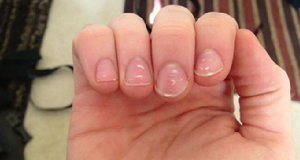
This is one of the most common nail defects and many people will experience it occasionally. They can be due to a calcium deficiency. Sometimes small white spots appear due to trauma to your cuticle and nail matric area. These should fade or grow out on their own. In some rare cases the white spots can be a fungal infection. If the spots seem to spread or persist you should seek the advice of a dermatologist.
Yellow Tinted Nails
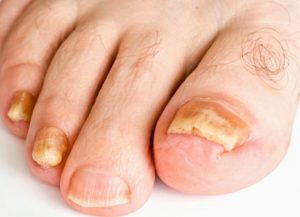 If your nails have become yellow in colour it could mean several things. In extreme cases yellow nails can be indicative of diabetes or thyroid issues. Psoriasis also causes yellowing of the nails, as do some respiratory issues, due to lack of oxygen supply to the system, including the nail bed area. Sometimes nails yellow with age, or because of excessive use of nail varnish. Smoking can also cause your nails to yellow.
If your nails have become yellow in colour it could mean several things. In extreme cases yellow nails can be indicative of diabetes or thyroid issues. Psoriasis also causes yellowing of the nails, as do some respiratory issues, due to lack of oxygen supply to the system, including the nail bed area. Sometimes nails yellow with age, or because of excessive use of nail varnish. Smoking can also cause your nails to yellow.
If your nails are yellow, cracked and crumbling, you most likely have a fungal infection, and you should seek the advice of a dermatologist.
Brittle, Dry and Cracked Nails
 Needless to say there are various external factors that can cause your nails to become dry and brittle – for example if you spend a lot of time with your hands in water, cleaning products or soaps or if you use nail varnish frequently. However, if you don’t expose your hands and nails to a lot of drying products, but you still suffer from dry and cracked nails, it could be an indication of a deeper problem.
Needless to say there are various external factors that can cause your nails to become dry and brittle – for example if you spend a lot of time with your hands in water, cleaning products or soaps or if you use nail varnish frequently. However, if you don’t expose your hands and nails to a lot of drying products, but you still suffer from dry and cracked nails, it could be an indication of a deeper problem.
Thyroid disease can cause your nails to become brittle, crack and split, particularly if you suffer from hypothyroidism.
These symptoms can also be due to vitamin deficiencies. Take a look at your diet. Have you been eating a healthy, well balanced diet – or could you be lacking in essential vitamins and minerals, including vitamin B, A or C.
Fungal infections can also cause cracking and splitting of your finger or toe nails. Be aware of any odour or discomfort with the condition.
Clubbing Nails
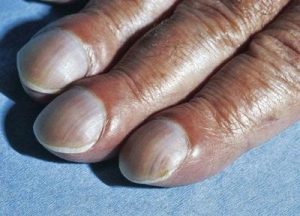 Clubbing is when your fingertips become swollen and the nails curve downward around the fingertips in a club-like shape. This condition is associated with lung disease and is caused by the low oxygen in your blood.
Clubbing is when your fingertips become swollen and the nails curve downward around the fingertips in a club-like shape. This condition is associated with lung disease and is caused by the low oxygen in your blood.
Clubbing can also be a sign of liver and kidney disease, inflammatory bowel disease and heart disease.
Spoon Nails

If your nails curve upwards at the edges creating a spoon like effect in the middle you may have an iron deficiency, hypothyroidism or heart disease.
Nail Ridges – Horizontal
 If you have horizontal white streaks or ridges across some or all of your nails, you might have Muehrcke’s lines. This is caused by a protein deficiency or a zinc deficiency. What happens is that the growth is interrupted and the flow of nutrients is stopped temporarily – causing the lines.
If you have horizontal white streaks or ridges across some or all of your nails, you might have Muehrcke’s lines. This is caused by a protein deficiency or a zinc deficiency. What happens is that the growth is interrupted and the flow of nutrients is stopped temporarily – causing the lines.
If using a supplement doesn’t improve the situation there is a possibility that it could be due to liver or kidney problems. Other conditions that can cause horizontal nail lines include diabetes, circulatory problems, and psoriasis.
It can also be caused by high fevers or trauma.
Nail Ridges – Vertical
Vertical ridges are a normal side effect of aging and may be experienced later in life without concern. It can be caused by lower levels of vitamin B12 and Magnesium.
Nail Dents and Pitting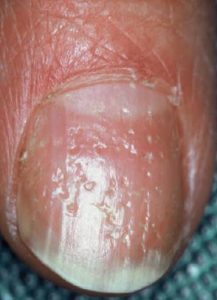
These are often a sign of psoriasis. It could also be caused by connective tissue disoreders such as Rieters syndrome. If it is coupled with hair loss it could be an autoimmune disease called Reiter’s syndrome.
Nails Discolorations
Black or brown streaks on your nails could be melanoma and should be seen by a medical professional immediately, especially if painful.
Terry Nails
 It’s normal to have small white half-moons above your cuticle area. However if they take over more than a third of the nail area it could be a sign of renal failure, diabetes or high blood pressure. The condition is known as Terry’s nails.
It’s normal to have small white half-moons above your cuticle area. However if they take over more than a third of the nail area it could be a sign of renal failure, diabetes or high blood pressure. The condition is known as Terry’s nails.
Final thoughts on nail abnormalities
If your nails are showing any of the above symptoms, it is important to monitor yourself for any other tell tale signs of illness. Most nail symptoms are due to nutrient deficiency in minerals and vitamins. In fact, the majority of the U.S. population is lacking in important nutrients. Not only can this lead to chronic diseases, but your nail (and hair and skin) health will also suffer.
What I would recommend you to do is to start juicing veggies and fruits every day. This will provide adequate nutrients for your body.
If you do not have enough time to do that, go to the next page to find out some superfoods to take instead.
About the Author:
Emma Deangela is the best selling author of The Alkaline Diet Program and 80/20 Fat Loss. She has helped over tens of thousands of men and women to lose weight and transform their health with sound nutrition advice. Trying to lose weight after the holiday binge? Learn how you can lose weight fast – How to lose weight by adding these alkaline foods.
Do you or your loved ones have the above nail symptoms? Which wonderful friends in your life would appreciate information about your nails?
Please help them by sharing this eye-opening article with each of them using any of the social media and email buttons below.
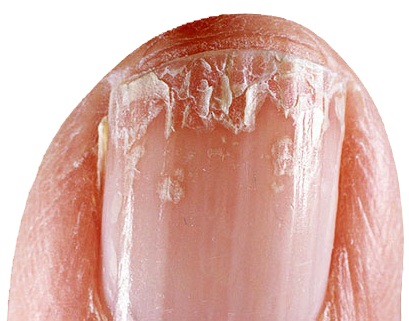

Leave a Reply